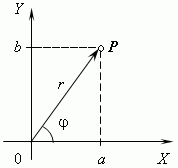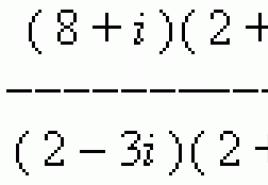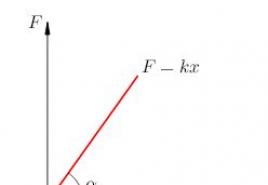Complex numbers theory and examples. Complex numbers
Complex numbers
Imaginary and complex numbers. Abscissa and ordinate
complex number. Conjugate complex numbers.
Operations with complex numbers. Geometric
representation of complex numbers. complex plane.
Modulus and argument of a complex number. trigonometric
complex number form. Operations with complex
numbers in trigonometric form. Moivre formula.
Basic information about imaginary and complex numbers are given in the section "Imaginary and complex numbers". The need for these numbers of a new type appeared when solving quadratic equations for the case
D< 0 (здесь Dis the discriminant of the quadratic equation). For a long time, these numbers did not find physical use, which is why they were called "imaginary" numbers. However, now they are very widely used in various fields of physics.and technology: electrical engineering, hydro- and aerodynamics, the theory of elasticity, etc.
Complex numbers are written as:a+bi. Here a and b – real numbers , a i – imaginary unit. e. i 2 = –1. Number a called abscissa, a b - ordinatecomplex numbera + b .Two complex numbersa+bi and a-bi called conjugate complex numbers.
Main agreements:
1. Real number
acan also be written in the formcomplex number:a + 0 i or a - 0 i. For example, entries 5 + 0i and 5 - 0 imean the same number 5 .2. Complex number 0 + bicalled purely imaginary number. Recordingbimeans the same as 0 + bi.
3. Two complex numbersa+bi andc + diare considered equal ifa = c and b = d. Otherwise complex numbers are not equal.
Addition. The sum of complex numbersa+bi and c + diis called a complex number (a+c ) + (b+d ) i .In this way, when added complex numbers, their abscissas and ordinates are added separately.
This definition follows the rules for dealing with ordinary polynomials.
Subtraction. The difference between two complex numbersa+bi(reduced) and c + di(subtracted) is called a complex number (a-c ) + (b-d ) i .
In this way, when subtracting two complex numbers, their abscissas and ordinates are subtracted separately.
Multiplication. The product of complex numbersa+bi and c + di is called a complex number.
(ac-bd ) + (ad+bc ) i .This definition stems from two requirements:
1) numbers a+bi and c + dishould multiply like algebraic binomials,
2) number ihas the main property:i 2 = – 1.
EXAMPLE ( a + bi )(a-bi) = a 2 +b 2 . Hence, work
two conjugate complex numbers is equal to the real
positive number.
Division. Divide a complex numbera+bi (divisible) to anotherc + di(divider) - means to find the third numbere + fi(chat), which, when multiplied by a divisorc + di, which results in the dividenda + b .
If the divisor is not zero, division is always possible.
EXAMPLE Find (8+i ) : (2 – 3 i) .
Solution. Let's rewrite this ratio as a fraction:
Multiplying its numerator and denominator by 2 + 3i
AND after performing all the transformations, we get:

Geometric representation of complex numbers. Real numbers are represented by points on the number line:
Here is the point Ameans number -3, dotB is the number 2, and O- zero. In contrast, complex numbers are represented by points on the coordinate plane. For this, we choose rectangular (Cartesian) coordinates with the same scales on both axes. Then the complex numbera+bi will be represented by a dot P with abscissa a and ordinate b (see fig.). This coordinate system is called complex plane .

module complex number is called the length of the vectorOP, depicting a complex number on the coordinate ( comprehensive) plane. Complex number modulusa+bi denoted by | a+bi| or letter r
Lesson plan.
1. Organizational moment.
2. Presentation of the material.
3. Homework.
4. Summing up the lesson.
During the classes
I. Organizational moment.
II. Presentation of the material.
Motivation.
The expansion of the set of real numbers consists in the fact that new numbers (imaginary) are added to the real numbers. The introduction of these numbers is connected with the impossibility of extracting the root from a negative number in the set of real numbers.
Introduction of the concept of a complex number.
The imaginary numbers with which we supplement the real numbers are written as bi, where i is the imaginary unit, and i 2 = - 1.
Based on this, we obtain the following definition of a complex number.
Definition. A complex number is an expression of the form a+bi, where a and b are real numbers. In this case, the following conditions are met:
a) Two complex numbers a 1 + b 1 i and a 2 + b 2 i equal if and only if a 1 = a 2, b1=b2.
b) The addition of complex numbers is determined by the rule:
(a 1 + b 1 i) + (a 2 + b 2 i) = (a 1 + a 2) + (b 1 + b 2) i.
c) Multiplication of complex numbers is determined by the rule:
(a 1 + b 1 i) (a 2 + b 2 i) = (a 1 a 2 - b 1 b 2) + (a 1 b 2 - a 2 b 1) i.
Algebraic form of a complex number.
Writing a complex number in the form a+bi is called the algebraic form of a complex number, where a- real part bi is the imaginary part, and b is a real number.
Complex number a+bi is considered equal to zero if its real and imaginary parts are equal to zero: a=b=0
Complex number a+bi at b = 0 considered to be a real number a: a + 0i = a.
Complex number a+bi at a = 0 is called purely imaginary and is denoted bi: 0 + bi = bi.
Two complex numbers z = a + bi and = a – bi, which differ only in the sign of the imaginary part, are called conjugate.
Actions on complex numbers in algebraic form.
The following operations can be performed on complex numbers in algebraic form.
1) Addition.
Definition. The sum of complex numbers z 1 = a 1 + b 1 i and z 2 = a 2 + b 2 i called a complex number z, the real part of which is equal to the sum of the real parts z1 and z2, and the imaginary part is the sum of the imaginary parts of the numbers z1 and z2, that is z = (a 1 + a 2) + (b 1 + b 2)i.
Numbers z1 and z2 are called terms.
The addition of complex numbers has the following properties:
1º. Commutativity: z1 + z2 = z2 + z1.
2º. Associativity: (z 1 + z 2) + z 3 = z 1 + (z 2 + z 3).
3º. Complex number -a -bi is called the opposite of a complex number z = a + bi. Complex number opposite of complex number z, denoted -z. Sum of complex numbers z and -z equals zero: z + (-z) = 0
Example 1: Add (3 - i) + (-1 + 2i).
(3 - i) + (-1 + 2i) = (3 + (-1)) + (-1 + 2) i = 2 + 1i.
2) Subtraction.
Definition. Subtract from complex number z1 complex number z2 z, what z + z 2 = z 1.
Theorem. The difference of complex numbers exists and, moreover, is unique.
Example 2: Subtract (4 - 2i) - (-3 + 2i).
(4 - 2i) - (-3 + 2i) = (4 - (-3)) + (-2 - 2) i = 7 - 4i.
3) Multiplication.
Definition. The product of complex numbers z 1 =a 1 +b 1 i and z 2 \u003d a 2 + b 2 i called a complex number z, defined by the equality: z = (a 1 a 2 – b 1 b 2) + (a 1 b 2 + a 2 b 1)i.
Numbers z1 and z2 are called factors.
Multiplication of complex numbers has the following properties:
1º. Commutativity: z 1 z 2 = z 2 z 1.
2º. Associativity: (z 1 z 2)z 3 = z 1 (z 2 z 3)
3º. Distributivity of multiplication with respect to addition:
(z 1 + z 2) z 3 \u003d z 1 z 3 + z 2 z 3.
4º. z \u003d (a + bi) (a - bi) \u003d a 2 + b 2 is a real number.
In practice, the multiplication of complex numbers is carried out according to the rule of multiplying the sum by the sum and separating the real and imaginary parts.
In the following example, consider the multiplication of complex numbers in two ways: by the rule and by multiplying the sum by the sum.
Example 3: Multiply (2 + 3i) (5 – 7i).
1 way. (2 + 3i) (5 – 7i) = (2× 5 – 3× (- 7)) + (2× (- 7) + 3× 5)i = = (10 + 21) + (- 14 + 15 )i = 31 + i.
2 way. (2 + 3i) (5 - 7i) = 2× 5 + 2× (- 7i) + 3i× 5 + 3i× (- 7i) = = 10 - 14i + 15i + 21 = 31 + i.
4) Division.
Definition. Divide a complex number z1 to a complex number z2, means to find such a complex number z, what z z 2 = z 1.
Theorem. The quotient of complex numbers exists and is unique if z2 ≠ 0 + 0i.
In practice, the quotient of complex numbers is found by multiplying the numerator and denominator by the conjugate of the denominator.
Let z 1 = a 1 + b 1 i, z 2 = a 2 + b 2 i, then



 .
.
In the following example, we perform division by the formula and the rule of multiplication by the conjugate of the denominator.
Example 4. Find a quotient  .
.
5) Raising to a positive integer power.
a) Powers of the imaginary unity.
Taking advantage of the equality i 2 \u003d -1, it is easy to define any positive integer power of the imaginary unit. We have:
i 3 \u003d i 2 i \u003d -i,
i 4 \u003d i 2 i 2 \u003d 1,
i 5 \u003d i 4 i \u003d i,
i 6 \u003d i 4 i 2 \u003d -1,
i 7 \u003d i 5 i 2 \u003d -i,
i 8 = i 6 i 2 = 1 etc.
This shows that the degree values i n, where n- a positive integer, periodically repeated when the indicator increases by 4 .
Therefore, to raise the number i to a positive integer power, divide the exponent by 4 and erect i to the power whose exponent is the remainder of the division.
Example 5 Calculate: (i 36 + i 17) i 23.
i 36 = (i 4) 9 = 1 9 = 1,
i 17 = i 4 × 4+1 = (i 4) 4 × i = 1 i = i.
i 23 = i 4 × 5+3 = (i 4) 5 × i 3 = 1 i 3 = - i.
(i 36 + i 17) i 23 \u003d (1 + i) (- i) \u003d - i + 1 \u003d 1 - i.
b) Raising a complex number to a positive integer power is carried out according to the rule of raising a binomial to the corresponding power, since it is a special case of multiplying identical complex factors.
Example 6 Calculate: (4 + 2i) 3
(4 + 2i) 3 = 4 3 + 3× 4 2 × 2i + 3× 4× (2i) 2 + (2i) 3 = 64 + 96i – 48 – 8i = 16 + 88i.
Complex numbers are a minimal extension of the set of real numbers familiar to us. Their fundamental difference is that an element appears that squared gives -1, i.e. i, or .
Any complex number has two parts: real and imaginary:
Thus, it is clear that the set of real numbers coincides with the set of complex numbers with zero imaginary part.
The most popular model for the set of complex numbers is the ordinary plane. The first coordinate of each point will be its real part, and the second - imaginary. Then the role of the complex numbers themselves will be vectors with the beginning at the point (0,0).
Operations on complex numbers.
In fact, if we take into account the model of the set of complex numbers, it is intuitively clear that addition (subtraction) and multiplication of two complex numbers are performed in the same way as the corresponding operations on vectors. Moreover, we mean the cross product of vectors, because the result of this operation is again a vector.
1.1 Addition.
(As you can see, this operation exactly corresponds to )
1.2 Subtraction, similarly, is performed according to the following rule:
2. Multiplication.

3. Division.
It is defined simply as the inverse operation of multiplication.

trigonometric form.
The modulus of a complex number z is the following quantity:
 ,
,
it is obvious that this, again, is simply the modulus (length) of the vector (a,b).
Most often, the modulus of a complex number is denoted as ρ.
It turns out that
z = ρ(cosφ+isinφ).

The following follows directly from the trigonometric form of writing a complex number. formulas :

The last formula is called De Moivre formula. The formula is derived directly from it. nth root of a complex number:

thus, there are n nth roots of the complex number z.







